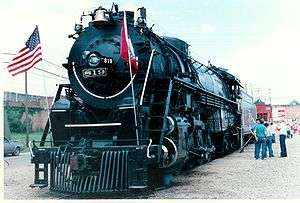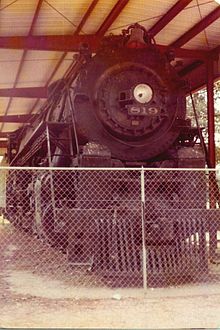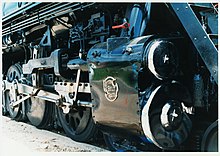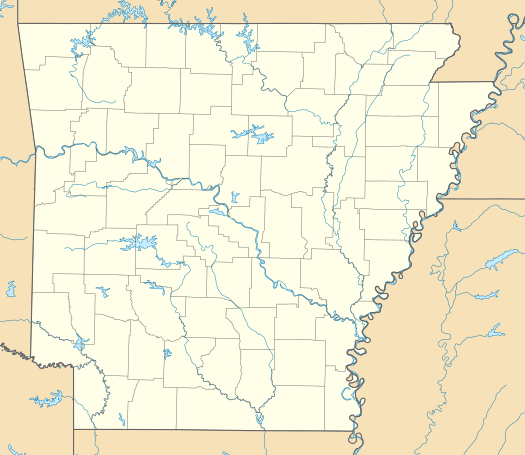St. Louis Southwestern 819
St. Louis Southwestern No. 819 is a 4-8-4 "Northern" type steam locomotive. It was completed in 1943 and was the last engine built by the St. Louis Southwestern Railway, which was affectionately known as "The Cotton Belt Route" or simply "Cotton Belt". It was also the last locomotive built in Arkansas. Today, it was now located at the Arkansas Railroad Museum, awaiting for restoration back to operating condition.
| St. Louis Southwestern 819 | |||||||||||||||||||||||||||||||||||||||||||||||||||||
|---|---|---|---|---|---|---|---|---|---|---|---|---|---|---|---|---|---|---|---|---|---|---|---|---|---|---|---|---|---|---|---|---|---|---|---|---|---|---|---|---|---|---|---|---|---|---|---|---|---|---|---|---|---|
 Cotton Belt No. 819 attends the Fordyce on the Cotton Belt Festival in 1986. | |||||||||||||||||||||||||||||||||||||||||||||||||||||
| |||||||||||||||||||||||||||||||||||||||||||||||||||||
| |||||||||||||||||||||||||||||||||||||||||||||||||||||
| |||||||||||||||||||||||||||||||||||||||||||||||||||||
| |||||||||||||||||||||||||||||||||||||||||||||||||||||
History
The Cotton Belt initially purchased ten "Northern" 4-8-4 engines (#800–809) from Baldwin Locomotive Works located at Eddystone, Pennsylvania in 1930. Seven years later, the Cotton Belt built five more Northern engines (#810–814) from their own shops in Pine Bluff, Arkansas in 1937. These Northern locomotives were Class L1 on the Cotton Belt.
In 1942, Cotton Belt officials petitioned the War Production Board for authorization to buy five new EMD FT diesel locomotives for their growing freight business. Instead, they were granted approval to produce five more 4-8-4 type locomotives (#815–819). Although similar to the previous set of five steam engines, these new locomotives had many modern improvements.
Since 819 was built during World War II, some materials were in short supply. The Cotton Belt emblems, which would have normally been made of brass, were made of steel to save brass for the war effort. Decorative emblems, numbers, etc., were also made of steel and chromium plating was entirely eliminated. Work on the new L1 Northerns began on Tuesday June 2, 1942. But delivery of the boilers from the Baldwin Locomotive Works lagged. The five new boilers were shipped by Baldwin to Pine Bluff between November 5 and December 12, 1942. The rail journey from Philadelphia to Pine Bluff took about five days for each boiler. Work by the Cotton Belt shop forces took an additional five or six weeks to complete each new locomotive.
On Monday February 8, 1943, the last of these five steam locomotives, Engine 819, was placed in active service. It was the final locomotive constructed by the Cotton Belt's own staff of mechanical engineers, mechanical officers, foremen and workers in the company shops at Pine Bluff, Arkansas. The cost to build was $143,607.00 and it was to be the last locomotive produced in Arkansas.[2]
Engine 819 traveled more than 804,000 miles during its 10½ years of service, before being forced aside by the more modern diesel locomotives. On July 19, 1955 Cotton Belt's President H. J. McKenzie presented retired Engine 819 to the City of Pine Bluff to show the Cotton Belt's gratitude for the part the city had played in their steam locomotive operations. McKenzie commented that this model engine is generally conceded to be one of the best designed and most attractive of its type ever built. He recalled how the engine had been built by local craftsmen, who were very proud of them and he hoped that the people of Pine Bluff would be equally proud to display it in their public park.
Retirement
In order to raise money for the cost of moving and constructing a permanent display structure for the engine, the City of Pine Bluff sold "shares" in the locomotive to the school children in Jefferson County. Children were requested to "buy" Engine 819 by contributing one penny per pound (the engine & tender weigh 541,300 pounds) and were presented with cards signed by the mayor indicating the number of "shares" purchased. It had been estimated they needed to raise $4,000.00 for the concrete based, metal roofed, pipe framed shed surrounded by a concrete walkway and 6-foot-high (1.8 m) fence. The problem of getting the locomotive moved to the display was solved when Cotton Belt agreed to lend materials for a temporary spur to the park. Cotton Belt and Missouri Pacific employees contributed the labor in building the spur and moving the historic locomotive and tender.[3]
However, just four years later, the Pine Bluff Commercial ran this note in the October 6, 1959 edition:
- A Commercial newsman's inspection this week of the Cotton Belt locomotive permanently on display on a site between Oakland and Townsend Parks revealed the old steam engine has been neglected by the city. When the railroad donated the engine to the city it did so with the stipulation that the locomotive would receive proper care. Not only had the engine been allowed to deteriorate through rust, the effects of the weather in non-metal portions and acts of vandalism, but the grounds have been allowed to grow up around the fenced-in area so that visitors must trudge through weeds to get an up-close look at the locomotive.[4]
It took most of a year to get 819's situation improved. It was decided to move the engine to a new location approximately 150 yards west of its old spot, near the front of the Reserve building. The Pine Bluff Jaycees spearheaded the drive to build a green and white steel shed at the new location, while the move and reconditioning was being coordinated by members of the Brotherhood of Railroad Trainmen and Cotton Belt employees. Several civic organizations talked of undertaking the project of restoring the engine to better condition, only to find out that such a project required technical know-how that only railmen possessed. That was when BRT stepped in and offered to assist with the engine.
"Before we're through," one of the men said "that old engine will look just like it did the day it rolled out of the shop she was built in. We hope to have her fixed where she'll be better taken care of, too."[5]
During the move to her new location between Townsend and Oakland Parks, Engine 819 "broke loose" and coasted down an incline on her temporary track. The locomotive, after starting to coast, rammed the park's lake embankment and finally stopped against a large black oak tree. The workmen labored the next day to get the engine back on her rails and into place. Crews stated they expected to have the locomotive in her new quarters in about two more weeks.[6]

Although the engine and tender were successfully relocated during the Fall of 1960, it was several more years before the steel shed was erected overhead to protect the locomotive. In addition to the Pine Bluff Jaycees, the City of Pine Bluff and the Pine Bluff Park Commission each donated $500. Pine Bluff Mayor Franks personally donated $250 and another $250 was donated by the Townsend Park Commission. Gene Gardner, an engineer with International Paper, designed the green and white steel shed and drew up the plans for it. International Paper Company and the Pine Bluff Sand & Gravel Company furnished the concrete footings for the shed, while Varco Steel did the construction work. Construction of the shed was completed in September 1965 when a chain-link fence was installed and the landscaping was finished.
Upon completion of Engine 819's new home in 1965, Mayor Austin Franks shared one of the two keys to the gate with long-time railfan James Norris. Norris' father had taken the locomotive out for her first run in 1943 and young James always remembered his late-father when he saw the engine. Despite being in his late 50s and in failing health, James Norris faithfully visited the locomotive every week to knock off the bird nests and occasionally replace some broken glass in the cab. He would open the gate on Sundays while he was there to let kids climb on the locomotive, ring the bell and answer their many questions.
"Every time I come out here I can see my daddy standing right on that step." Norris said "It kinda gets down in your heart."[7]
It is uncertain when Mr. Norris' health got so bad that he could no longer continue his weekly maintenance visits to the 819, but he admitted in 1965 that his doctor had told him to stay away from the locomotive. Records indicate that Mr. Norris died in 1970 and by 1983 the Arkansas Democrat described the locomotive as "covered in graffiti and vandals have removed, or tried to take, whatever wasn't too heavy to carry off." Miss Arkansas of 1958, Sally Miller Perdue, from Pine Bluff complained "It had been abandoned and stripped of all its dignity. It has become the iron-horse that was put out to pasture, neglected and abused."
Ms. Perdue, whose family had a long history with the railroad, agreed to chair a sub-committee of the Chamber of Commerce's Publicity & Tourism to get the 819 rejuvenated and relocated. With a slogan of "Let's Put the Steam Back in Pine Bluff", she felt that a lot of volunteers, mainly retired Cotton Belt craftsmen and engineers, would be interested in working to restore the 819. Superintendent R. R. McClanahan of the Cotton Belt Pine Bluff Division worked hard to get the locomotive and tender transported from the park back to the shops to make those repairs.[8]
Return to the Cotton Belt shops
On December 1, 1983, a force of between 50–100 Cotton Belt employees, most of them volunteers, assisted railfans and rail historical groups, placed Engine 819 back on Cotton Belt rails for the first time in nearly three decades and transported the engine 3 1⁄2 miles (5.6 km) from the park back to the site of its manufacturing 40 years earlier. Members of the newly formed Cotton Belt Rail Historical Society moved the locomotive back to the Cotton Belt shops, where it was to be restored in a bold project to show Arkansans what past gigantic locomotives looked like.[9]
Although the ownership of the locomotive was retained by the city, the restoration of the 819 was the responsibility of "Project 819", an all-volunteer effort by two rail historical preservation groups: the Arkansas Railroad Club and the Cotton Belt Rail Historical Society. The project leased space needed at the Cotton Belt shops in Pine Bluff to complete the restoration, which was projected to take 18–24 months.[10]
While the engine languished in the park, various parts disappeared including its bell, whistle, Cotton Belt emblems and many of the gauges. Jake Commer, President of the Cotton Belt Rail Historical Society at the time, offered a "no questions asked" policy for the return of these items and received many of the parts back, including the whistle and one of the emblems. The original bell was never located however and the one currently on the engine is from another 800 class locomotive. That bell was used for many years by the Wesley United Methodist Church in Pine Bluff before being donated to Project 819.[11]
Led by Bill B. Bailey, the Restoration Director for "Project 819", seven separate volunteer groups worked six days a week on various sections of the locomotive and tender in hopes of getting the engine totally restored and federally certified as worthy to run on the rails again. Mr. Bailey estimated that about 20% of the volunteers had actually worked on the locomotive or went through an apprenticeship in the early 1940s when the 819 or other 800-class steam locomotives were built in the Cotton Belt Shops at Pine Bluff.[10]
Engine 819 was listed on the National Register of Historic Places in 2003.[1]
Excursions

On April 6, 1986, Engine 819 moved out of the Cotton Belt Route's yard at Pine Bluff marking the first time it had moved under its own power since 1953. The large crowd gathered at the railyard, including a number of railroad employees, burst into applause and shouted their approval as the locomotive's nose emerged from the shop building and into the bright sunshine. The American flag and the Arkansas state flag affixed to the right and left sides of the shiny black engine gave a patriotic air to the event. Members of the Cotton Belt Railroad Historical Society invested over 35,000 man-hours into this restoration project. Jake Commer praised the efforts the Cotton Belt Route had extended stating, "They helped us so much I can't even begin to tell you about all of it. If it hadn't been for the railroad, we couldn't have done it."[12]
Twenty days later, on April 26, 1986, Engine 819 pulled into Fordyce on her first full-fledged trip out of Pine Bluff in 31 years. School children from Pine Bluff, Rison, Kingsland and Fordyce waved and shouted their delight at the engine. Cars of railfans followed the train's path, taking pictures.[13]
On June 13, 1986, Engine 819 participated in the Arkansas State Sesquicentennial with a trip to Little Rock and was perhaps Pine Bluff's most visible contribution to the weekend events marking the state's 150th birthday. In addition to Pine Bluff's Mayor Robinson, Louis Ramsay - Chairman of the state's Sesquicentennial Commission, and Judge Earl Chadick, Sr. of Jefferson County, Hillary Clinton also rode up from Pine Bluff in the opulent VIP car named "The Houston" on loan from the Cotton Belt. Governor Bill Clinton joined his wife and the other riders on board when the train slowed to a crawl behind Barton Coliseum, just minutes from Little Rock's Union Station. Engine 819 spent the weekend on display at Union Station, just a few blocks north of the state capitol, as part of Arkansas' Sesquicentennial celebration, before returning to Pine Bluff.[14]
During the summer of 1986, film crews came to Pine Bluff for the production of the movie End of the Line. Engine 819 played a minor role along with 35 Pine Bluff residents turned-actors, many of them members of the Cotton Belt Rail Historical Society who had helped restore the steam engine. Arkansas-born actress Mary Steenburgen was the film's executive producer, who worked hard to be able to use the newly restored locomotive for the movie.[15] On August 27, Pine Bluff residents were treated to a special premiere showing of the Orion Pictures film at the Pine Mall Cinema. Proceeds from the $5.00 tickets were given to the Cotton Belt Rail Historical Society.
For the next seven years, the locomotive traveled on numerous excursions, including a trip to the 1990 NRHS convention in St. Louis, where it stood at Union Station with Union Pacific Railroad's No. 844, Frisco No. 1522 and Norfolk & Western No. 1218.[16] No. 819 ran its final excursion train to Tyler, Texas in October 1993.
Today, the locomotive is partially disassembled for its mandated 15-year Federal Railroad Administration inspection. The boiler has been “ultra-sounded” and documented, with only a small area of the firebox remaining to be checked. The flue tubes were removed with plans made for their replacement. A sudden increase in material costs and various emergency repairs needed at the museum over the years have exhausted funds that were hoped to be used to complete the project. The locomotive has sat idle inside the museum, awaiting its return to steam and possible future travels.[17]
References
- "National Register Information System". National Register of Historic Places. National Park Service. July 9, 2010.
- Pine Bluff Commercial, February 7, 1943
- Pine Bluff Commercial, Hey Kids! You Can Buy Shares in a Real Choo-Choo by Jack Bradley - April 15, 1955
- Pine Bluff Commercial, October 6, 1959
- Pine Bluff Commercial, Trainmen Moving 'Old No. 819' to New Home - September 25, 1960
- Cotton Belt Railroad Historical Society Newsletter
- Pine Bluff Commercial, Locomotive at Oakland Park Now in Shape; Painting Over - September 3, 1965 (page 3)
- Arkansas Democrat, Former Miss Arkansas Tries to Put the Steam Back Into '819' by Randy Tardy - April 10, 1983
- Cotton Belt News, Spring 1984. Vol. 31, No. 1
- Arkansas Gazette, Restoration of the Old 819 to Start From the Ground Up by Randy Tardy - December 18, 1983
- Arkansas Democrat, Restoration of Steam Locomotive Chugs Along by Randy Tardy - May 1, 1985
- Arkansas Gazette, '819' on the Rails Again by Philip Launius - April 10, 1986
- Pine Bluff Commercial, New 819 Rolls out to Cheers by Jane Gore - April 26, 1986
- Pine Bluff Commercial, Engine Travels to Capital by James M. Hopkins - June 14, 1986
- Pine Bluff Commercial, Cameras Roll on 'Hot' Local Star by James M. Hopkins - July 27, 1986
- "National Railway Historical Society 1990 Annual Convention" (PDF). St. Louis Chapter, NRHS. June 14–17, 1990. Archived from the original (PDF) on April 14, 2016. Retrieved June 23, 2019.CS1 maint: date format (link)
- "NRHS News" National Railway Historical Society, Chapter Seeks Funds to ‘re-steam’ Locomotive by Steve Rankin, April 2009 Newsletter, page 5
External links
| Wikimedia Commons has media related to St. Louis Southwestern 819. |

